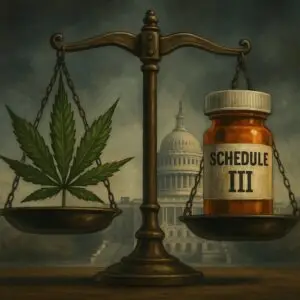
Filibuster and federal marijuana legalization
Last years have been very important for cannabis legalization. Currently, fifteen states, two territories and the District of Columbia have legalized cannabis for adult recreational use. New York is the most recent state to legalize cannabis, which was passed in late March 2021, during New York’s 2021 session.
And the road ahead seems promising for states Cannabis legalization, with states like Virginia or New Mexico that have proposed the implementation of recreational marijuana legalization bills that would establish a regulated commercial market. More and more states are taking the initiative to decriminalize or directly legalize recreational marijuana.
However -on the other hand- federal legalization doesn’t look so favorable. Recently, Michigan urged Congress of the United States to clarify its position on the legality of marijuana under the Federal Controlled Substances Act.
Under federal law -unfortunately- marijuana is still a Schedule I illegal substance. And considering that there’s a 50-50 split in the 117th U.S. Congress, federal legalization probably won’t be happening anytime soon, as the Republicans would be able to repeal it by filibustering.
What’s a Filibuster?
A Filibuster, according to the United States Senate’s glossary, is an “informal term for any attempt to block or delay Senate action on a bill or other matter by debating it at length, by offering numerous procedural motions, or by any other delating or obstructive actions”.
The most common form of filibuster occurs when one or more senators attempt to delay or block a vote on a bill by extending debate on the measure. The Senate rules permit a senator, or a series of senators, to speak for as long as they wish, and on any topic they choose, unless “three-fifths of the Senators duly chosen and sworn” (currently 60 out of 100) vote to bring the debate to a close by invoking cloture -AKA: a motion to end a debate- under Senate Rule XXII.
However, today -even though the filibuster is more common than ever- it is not necessary for a senator to talk for hours to maintain a filibuster. Nowadays, all it takes to perform a filibuster is for a senator to state his intention to launch a filibuster against a bill or motion.
Immediately after the senator’s intention is stated, a vote has to be taken, and only after getting at least 60 votes any action could be taken on the matter, getting less than 60 votes would mean the bill or motion got blocked.
It can be described -basically- as a move in which senators demand a supermajority to cut off debate and move to an actual vote.
For a quick assessment of your needs – let’s talk to discuss how Trusts can help your business.
History of the Filibuster
Being able to block a measure through extended debate was generated as a side effect of an 1806 rule change.
This tactic was infrequently used during much of the 19th and 20th centuries. In 1970, the Senate adopted a “two-track” procedure to prevent filibusters from stopping all other Senate business and thus .
The minority then felt politically safer in threatening filibusters more regularly, which became normalized over time to the point that 60 votes are now required to end debate on nearly every controversial legislative item.
Laws that expressly restrict the time for Senate discussion, such as the Congressional Budget and Impoundment Control Act of 1974 -which established the budget reconciliation mechanism- have been used to limit the procedure.
Changes in 2013 and 2017 now require only a simple majority to invoke cloture on nominations, although most legislation still requires 60 votes. Although one or more senators can still hold the floor for a prolonged period of time on occasion, often without the Senate leadership’s knowledge.
However, since the Senate’s ability to act eventually depends on whether there are enough votes to invoke cloture and proceed to a final vote on passage, these “filibusters” generally only cause small delays and have little influence on the outcome.
Filibustering was actually created by accident in 1806. In 1789, the first U.S. Senate adopted rules allowing senators to move the previous question by simple majority vote, which meant ending the debate and proceeding to vote.
At that time, Vice President Aaron Burr argued that the previous-question motion was redundant, had only been exercised once in the preceding four years and, therefore, it should be eliminated, which was done in 1806.
These changes on the Senate’s rules made filibustering possible, as it didn’t create another alternative to terminate the debate.
The senate allowed the tactic to be used until more than a century later, in 1917, when -during World War I- a rule allowing cloture of a debate was adopted by the Senate after the urging of President Woodrow Wilson, after a group of 12 anti-war senators managed to kill a bill that would have allowed Wilson to arm merchant vessels in the face of unrestricted German submarine warfare.
From 1917 to 1949, the requirements for cloture were two-thirds of the senators voting. During this period of time, there were times where politicians recited Shakespeare and read out recipes for hours at a time, some of them occupying as long as 15 hours of debate.
In 1949 the Senate made invoking cloture even more difficult by requiring two-thirds of the entire Senate membership to vote in favor of a cloture motion. Then, ten years later, in 1959 -anticipating more civil rights legislation- the Senate restored the cloture threshold to two-thirds of those voting.
In 1970 the Senate introduced a “two-track system”, which would allow the majority leader -with unanimous consent or the agreement of the minority leader- to have more than one main motion pending on the floor as unfinished business.
Under this system, the Senate can have two or more pieces of legislation or nominations pending on the floor simultaneously by designating specific periods during the day when each one will be considered.
Filibusters became easier for the minority to retain as a result of this change. This also led to the modern era in which an effective supermajority requirement exists to pass legislation, with no practical requirement that the minority party actually hold the floor or extend debate.
In 1975, the Senate revised its cloture rule so that three-fifths of sworn senators (60 votes out of 100) could limit debate, except for changing Senate rules which still requires a two-thirds majority of those present and voting to invoke cloture.
However, by returning to an absolute number of all Senators (60) rather than a proportion of those present and voting, the change also made any filibusters easier to sustain on the floor by a small number of senators from the minority party without requiring the presence of their minority colleagues.
This further reduced the majority’s leverage to force an issue through extended debate.
Exceptions for the Filibuster
There are some bills that are not subject to the effective 60-vote requirements. These are bills that -under provisions of law- have a limited time for debating them. These limits on debate allow the Senate to hold a simple-majority vote on final passage without obtaining the 60 votes normally needed to close debate:
- Budget reconciliation. Expedites the passage of certain budgetary legislation.
- Trade promotion authority. Gives authority to the President to negotiate international trade agreements in a “fast track”
- Congressional review act. Allows Congress to review and repeal administrative regulations adopted by the Executive Branch within 60 legislative days.
- National emergencies act. Formalizes the emergency powers of the President.
- War powers resolution. Generally, requires the President to withdraw troops committed overseas within 60 days, which the President may extend once for 30 additional days.
How to end a Filibuster
As of today, according to the rules set for debate in the United States Senate, 60 votes are needed to end a filibuster. Once the debate is closed, senators can move forward with consideration of the measure, amendments or final votes.
The issue is that, nowadays, with the Congress split in half, this isn’t possible, as the Republicans are unlikely to vote against the filibuster. And what’s even more, Democrats would have to tread lightly this session, to ensure they don’t upset the Republicans, as doing so could cost any chance at passing even the smallest reform.
How could the Democrats kill the filibuster and what’s the “Nuclear Option”?
Another option that the Democrats have in order to pass federal legalization would be the so-called “nuclear option”.
The “nuclear option” is a parliamentary procedure that allows the Senate to override a standing rule of the Senate, such as the three-fifths vote rule to close debate, by a simple majority.
The option is invoked when the majority leader raises a point of order that contravenes a standing rule. The term “nuclear option” is an analogy to nuclear weapons being the most extreme option.
The “nuclear option” would allow the Senate to override one of its standing rules, including the 60-vote rule to close debate, by a simple majority (51+ votes or 50 votes with the Vice President casting the tie-breaking vote), rather than the two-thirds supermajority normally required to amend the rules. To this day, the “nuclear option” has never been used to kill the filibuster.
In this sense, it would be possible for the Democrats to change the rules for the filibuster. However, Senate minority leader, Mitch McConnell doesn’t want the filibuster to die, and has decided to not negotiate with Democrats until they agree to keep it in play.
In the current state of the Senate, where there’s a 50/50 division, it would be fairly complicated to change these rules, as the Senate would need -at least- 51 votes, which means that every single Democrat would need to be on board to change the rules, which can be a bit tricky, as there are some of them who have -openly- been in favor of filibuster in the past.
What’s even more, let’s say that the Democrats find a way to eradicate the filibuster and start passing bills on marijuana legalization. According to Sen. McConnell, this could lead to a situation where any marijuana reform bill passed under Democratic control would just end up tossed off the books once Republicans take back the power.
“When Republicans next control the government, we’d be able to repeal every bill that had just been rammed through. But a few years later, Democrats would try to flip it all back. So instead of building stable consensus, we’d be chaotically swapping party platforms.” – Sen. Mitch McConnell
From this point of view, it wouldn’t be the smartest idea to kill the filibuster as it would possibly take away the possibilities of legalizing cannabis on a federal level in an effective -and durable- way.
It could take away the possibilities of passing any kind of reform the Biden administration would want to pass.
And with the landscape being the way it is, It seems like federal legalization won’t be occurring any time soon.
For a quick assessment of your needs – let’s talk to discuss how Trusts can help your business.
Whether this is your first land use issue or most recent, our office has helped people and businesses alike.
Thomas Howard was on the ball and got things done. Easy to work with, communicates very well, and I would recommend him anytime.





